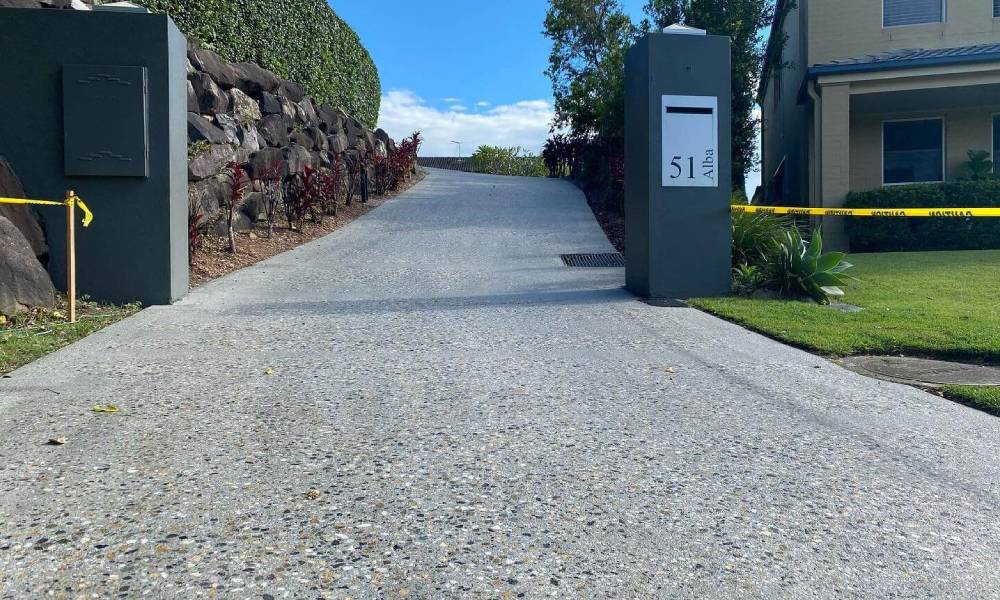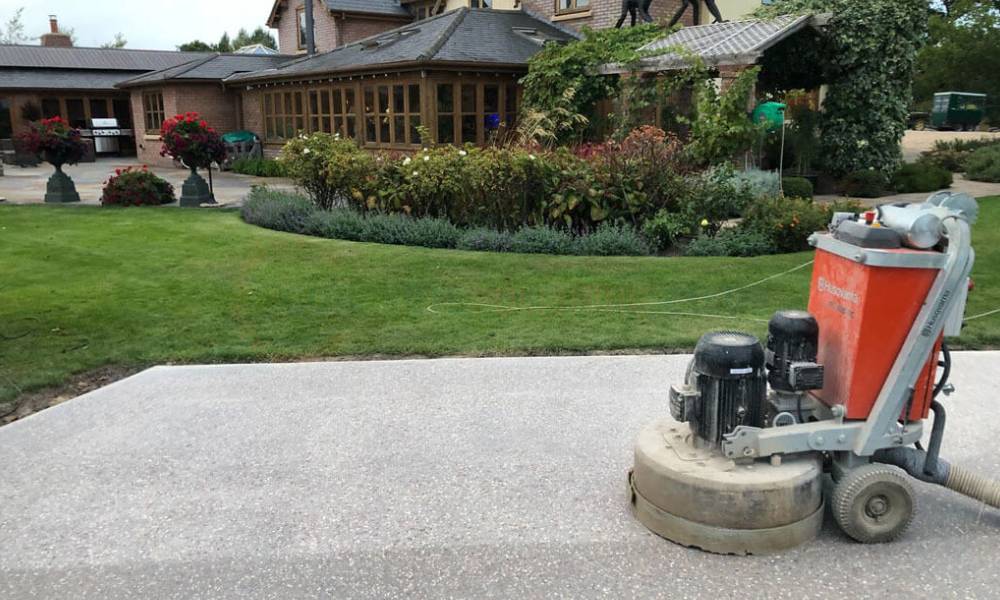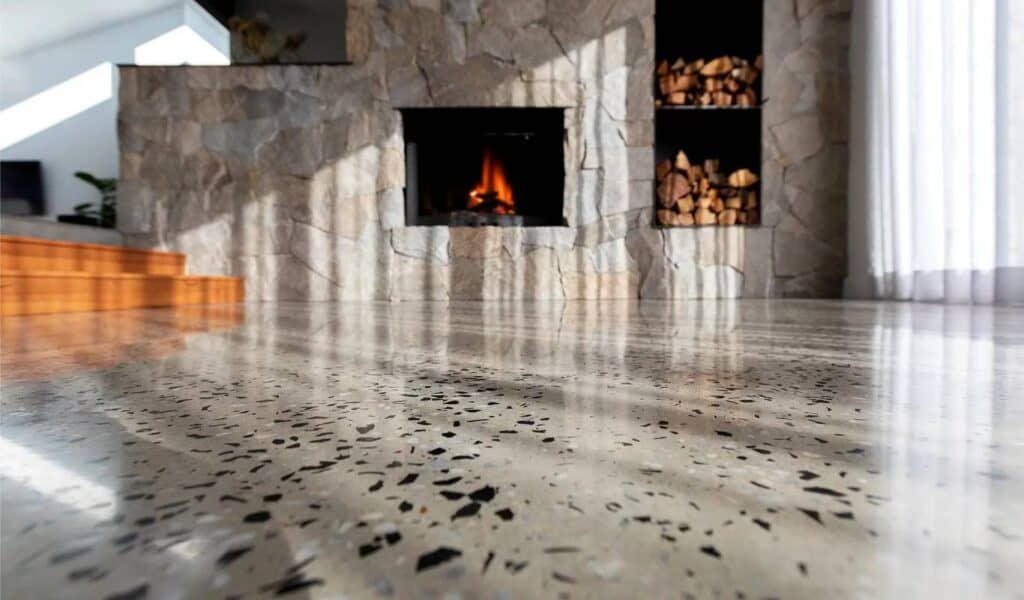Exterior polished concrete is a type of concrete that has been polished to a high shine. It is done by the process of treating and finishing the surface of a concrete slab to achieve a smooth, glossy, and durable finish suitable for outdoor applications.
The process involves a series of grinding, honing, and polishing steps using specialised equipment and abrasive materials to enhance the appearance. Polished concrete is a popular choice for indoor and outdoor applications, as it is durable, low maintenance, and easy to clean.
Can You Have Polished Concrete Outside?
Yes, you can have polished concrete outside. With proper care, polished concrete can be a durable and beautiful surface for your home. If you hire professionals for this job, you can get an attractive-looking concrete look in outdoor swimming pools, entertaining areas, commercial foyers, external walkways, and outdoor public spaces.
However, there are some things to keep in mind if you choose to do this; polished concrete can be an issue in a few cases, but I have added quick fixes along with them.
- Polished concrete can be slippery when wet. This is a major safety concern, especially in areas with much foot traffic, such as near pools or spas. You can count on a non-slip additive mixed with the sealer to make polished concrete safer.
- Polished concrete can be damaged by the sun. The ultraviolet (UV) rays coming from the sun can cause the concrete to fade and crack. To protect your polished concrete from the sun, you should seal it regularly.
- Polished concrete can be etched by acids. Spills of acidic substances, such as citrus fruits or cleaning products, can carve the surface of polished concrete. To prevent this, you should clean up spills immediately and seal the concrete regularly.
Benefits of Using Exterior Polished Concrete
Many experts recommend polished concrete if you want to utilise the unutilised outdoor space in your home while matching the indoor aesthetics. Not only affordable compared to using tiles but also give you many other benefits.
- Durability – An enduring surface that can withstand the elements. It is resistant to cracking, fading, and staining.
- Low-Maintenance – A low-maintenance surface that does not require waxing or sealing. It can be washed with a typical hose and broom.
- Slip-Resistant – Can be made slip-resistant by incorporating a non-slip additive to the sealer. This is important for areas with a risk of slipping, such as near pools or spas.
- Customisable – The polish level of concrete can be customised to the desired finish, creating a unique look.

Ways to Use Outdoor Concrete
Polished concrete for outdoor spaces offers limitless possibilities limited only by your imagination. You can consider these landscaping design applications that can incorporate the beauty of polished concrete.
Patios and Terraces
Create an inviting outdoor entertainment area using polished concrete for your patio or terrace. Its sleek and glossy finish adds elegance and sophistication to your space, making it an ideal setting for gatherings, barbecues, or simply relaxing outdoors.
Walkways and Pathways
Enhance the functionality and aesthetics of your outdoor pathways with polished concrete. Its smooth surface provides a comfortable and safe walking experience while adding a touch of modernity to your landscape design.
Pool Decks
Complement your swimming pool area with the luxurious appeal of polished concrete. The slip-resistant properties make it a practical choice, while the reflective surface can beautifully highlight the sparkling water and create a visually stunning ambience.
Driveways
Make a lasting impression by using polished concrete for your driveway. Not only does it provide a durable and long-lasting surface, but it also adds a touch of sophistication to your property’s curb appeal.
Outdoor Kitchen Countertops
Consider using polished concrete for your kitchen countertops for an outdoor culinary space that exudes style and functionality. It’s easy-to-clean, and the smooth surface makes it an excellent choice for outdoor cooking and dining areas.
Garden Features
Incorporate polished concrete into your garden design to create eye-catching and unique features. From decorative planters and seating to artistic sculptures and fountains, polished concrete can add a contemporary and artistic element to your outdoor oasis.
Exterior Polished Concrete Process
Concrete is just concrete until it faces the polishing process and becomes what we admire as exterior polished concrete. But how does it really happen? Well, below is the typical process of exterior polished concrete.

Surface Preparation
The concrete surface is comprehensively cleaned, and any existent coatings, sealers, or contaminants are withdrawn. This step ensures proper adhesion and allows the concrete to be effectively polished.
Grinding
Coarse grinding is performed using diamond-embedded abrasive pads or discs to remove any surface imperfections, such as bumps, rough spots, or minor cracks. This process gradually levels the concrete and exposes the desired amount of aggregate (stones) within the slab.
Honing
Finer-grit abrasives are used to refine the surface and achieve a smoother texture. This step removes the scratches and marks left by the initial grinding, resulting in a more uniform appearance and improved clarity.
Polishing
Multiple polishing steps follow, utilising finer and finer grit abrasives to create a glossy finish. This process enhances the concrete’s sheen, depth, and reflectivity. Special polishing compounds may also be applied to improve shine and durability.
Densifying and Sealing
A densifying agent may be applied to the polished concrete to strengthen the surface and reduce porosity, making it more resistant to staining and wear. A sealer is then applied to protect the concrete from chemicals, moisture, and UV damage while enhancing its colour and lustre.



